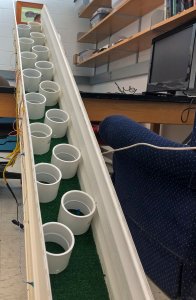
Learnin’ Lizards!
Ohio Wesleyan Student Researches How Lizard’s Body Shape Affects Speed
Name: Princeton Vaughn ’22
Hometown: Bowie, Maryland
Majors: Zoology, Environmental Science, and Music Composition
OWU Connection Experience: Ohio Wesleyan’s Summer Science Research Program

Vaughn is spending 10 weeks studying “How Morphological Mechanisms Affect the Performance of the Common Wall Lizard (Podarcis muralis)” under the mentorship of Eric Gangloff, Ph.D., assistant professor of Zoology. The lizard is widespread in Europe and invasive in parts of North America.
What I’m Researching
“In layman’s terms, my research idea tries to relate the morphology (body shape) of a lizard to their performance (how fast they run in a variety of conditions).
“This research addresses a lot of big ideas in ecology and evolutionary biology. Since these lizards are invasive, we would like to see if they’re expanding their range northwards.
“We also would like to understand how their morphology changes due to their new environment and if, and to what degree, those morphological changes affect their sprint speed.
“We would also like to see if the changes in morphology cause performance to increase in one environment but decrease in another. Basically, this experiment allows us to study the invasion ecology of Podarcis muralis.”
My Methodology
“To do this, we constructed a 2-meter long racetrack with interchangeable substrates. We chose sandpaper, cork bark, and artificial grass (AstroTurf) because they are comparable to substrates that Podarcis muralis would encounter in the wild.
“This allows us to test how these lizards run on various substrates. Also, we have obstacles which the lizards will have to run between. In addition, we also would like to test the effects of incline on sprint speed. We have set up the racetrack so the incline is 30 degrees. So overall, the racetrack will allow us to test the effects of substrate type, presence of obstacles, and incline on sprint speed.
“We will measure morphology by measuring various body dimensions. We will also look at toe samples under the scanning electron microscope. We are trying to find any microstructures that could possibly influence the sprint speed of the lizard.”
What I Hope to Learn
“This summer, I hope to learn about experimental design and working with live animals. I also plan for this to be the basis of an honors thesis and plan to continue working on this project until I graduate.
“This research ties into classroom learning. In classes such as evolution and introductory biology, we learned about the basics of the morphology-performance-fitness paradigm, which is the basis of this project.”
My Plans After Graduation
“My research ties heavily into my future plans. After I graduate, I would like to start my Ph.D. This research project will be invaluable when applying to those programs. After I, hopefully, get my Ph.D., I would like to get a job as a research scientist.”
Why I Chose Ohio Wesleyan
“I decided to attend OWU because of the Zoology department and the small size. I heard that the professors were top-notch. I really liked everyone I met when I was touring and the campus was small but beautiful.”
